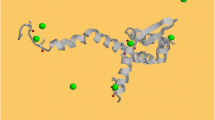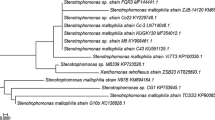Abstract
The recently annotated genome of the bacterium Cronobacter sakazakii BAA-894 suggests that the organism has the ability to bind heavy metals. This study demonstrates heavy metal tolerance in C. sakazakii, in which proteins with the heavy metal interaction were recognized by computational and experimental study. As the result, approximately one-fourth of proteins encoded on the plasmid pESA3 are proposed to have potential interaction with heavy metals. Interaction between heavy metals and predicted proteins was further corroborated using protein crystal structures from protein data bank database and comparison of metal-binding ligands. In addition, a phylogenetic study was undertaken for the toxic heavy metals, arsenic, cadmium, lead and mercury, which generated relatedness clustering for lead, cadmium and arsenic. Laboratory studies confirmed the organism’s tolerance to tellurite, copper and silver. These experimental and computational study data extend our understanding of the genes encoding for proteins of this important neonatal pathogen and provide further insights into the genotypes associated with features that can contribute to its persistence in the environment. The information will be of value for future environmental protection from heavy toxic metals.


Similar content being viewed by others
References
Altschul SF, Gish W, Miller W, Myers EW, Lipman DJ (1990) Basic local alignment search tool. J Mol Biol 215:403–410
Bairoch A, Boeckmann B, Ferro S, Gasteiger E (2004) Swiss-Prot: juggling between evolution and stability. Brief Bioinform 5:39–55
Benson DA, Karsch-Mizrachi I, Lipman DJ, Ostell J, Rapp BA, Wheeler DL (2000) GenBank Nucleic Acids Res 28:15–18
Bernstein FC, Koetzle TF, Williams GJB, Meyer EF Jr, Brice MD, Rogers JR, Kennard O, Shimanouchi T, Tasumi M (1977) The Protein Data Bank: a computer-based archival file for macromolecular structures. J Mol Biol 112:535–542
Brathwaite RL, Rabone SDC (1985) Heavy metal sulphide deposits and geochemical surveys for heavy metals in New Zealand. J R Soc N Z 15(4):363–370
Chasteen TG, Fuentes DE, Tantalean JC, Vasquez CC (2009) Tellurite: history, oxidative stress, and molecular mechanisms of resistance. FEMS Microbiol Rev 33:820–832
Chaturvedi N, Pandey PN (2014) Phylogenetic analysis of gammaproteobacterial arsenate reductase proteins specific to Enterobacteriaceae family, signifying arsenic toxicity. Interdiscip Sci 6(1):57–62
De Castro E, Sigrist CJA, Gattiker A, Bulliard V, Langendijk-Genevaux PS, Gasteiger E, Bairoch A, Hulo N (2006) ScanProsite: detection of PROSITE signature matches and ProRule-associated functional and structural residues in proteins. Nucleic Acids Res 34:W362–W365
Falquet L, Pagni M, Bucher P, Nicolas Hulo, Sigrist CJA, Hofmann K, Bairoch A (2002) The PROSITE database, its status in 2002. Nucleic Acids Res 30:235–238
Forsythe SJ, Dickins B, Jolley KA (2014) Cronobacter, the emergent bacterial pathogen Enterobacter sakazakii comes of age; MLST and whole genome sequence analysis. BMC Genom 15:1121
George RA, Spriggs RV, Bartlett GJ, Gutteridge A, MacArthur MW, Porter CT, Al-Lazikani B, Thornton JM, Swindells MB (2005) Effective function annotation through catalytic residue conservation. Proc Natl Acad Sci USA 102:12299–12304
Gilmour MW, Thompson NR, Sanders M, Parkhill J, Taylor D (2004) The complete nucleotide sequence of the resistance plasmid R478: defining the backbone components of incompatibility group H conjugative plasmids through comparative genomics. Plasmid 52:182–202
Golovin A, Henrick K (2008) MSDmotif: exploring protein sites and motifs. BMC Bioinform 9:312
Golovin A, Henrick K (2009) Chemical substructure search in SQL. J Chem Inf Model 49:22–27
Golovin A, Dimitropoulos D, Oldfield T, Rachedi A, Henrick K (2005) MSDsite: a database search and retrieval system for the analysis and viewing of bound ligands and active sites. Proteins 58:190–199
Iversen C, Forsythe S (2003) Risk profile of Enterobacter sakazakii, an emergent pathogen associated with infant milk formula. Trends Food Sci Technol 14:443–454
Joseph S, Forsythe SJ (2011) Predominance of Cronobacter sakazakii ST4 with neonatal infections. Emerg Infect Dis 17:1713–1715
Joseph S, Sonbol H, Hariri S, Desai P, McClelland M, Forsythe SJ (2012) Diversity of the Cronobacter genus as revealed by multi locus sequence typing. J Clin Microbiol 50:3031–3039
Kucerova E, Clifton SW, Xia XQ, Long F, Porwollik S et al (2010) Genome sequence of Cronobacter sakazakii BAA-894 and comparative genomic hybridization analysis with other Cronobacter species. PLoS One 5:e9556
Kucerova E, Joseph S, Forsythe S (2011) Cronobacter: diversity and ubiquity. Qual Assur Saf Foods Crops 3:104–122
Livingstone CD, Barton GJ (1996) Identification of functional residues and secondary structure from protein multiple sequence alignment. Methods Enzymol 266:497–512
Magrane M, the UniProt consortium (2011) UniProt Knowledgebase: a hub of integrated protein data, Database, bar009
Mergea M (2007) Plasmids pMOL28 and pMOL30 of Cupriavidus metallidurans are specialized in the maximal viable response to heavy metals. J Bacteriol 189:7417–7425
Nicolas H, Sigrist CJA, Le Saux V, Langendijk-Genevaux S, Bordoli L, Gattiker A, De Castro E, Bucher P, Bairoch A (2004) Recent improvements to the PROSITE database. Nucleic Acids Res 32(Database issue):D134–D137
Nies DH (1999) Microbial heavy-metal resistance. Appl Microbiol Biotechnol 51:730–735
Osaili T, Forsythe S (2009) Desiccation resistance and persistence of Cronobacter species in infant formula. Intl J Food Microbiol 136:214–220
Ouzounis C, Perez-Irratxeta C, Sander C, Valencia A (1998) Are binding residues conserved? Pac Symp Biocomput 3:401–412
Pilon-Smits E (2005) Phytoremediation. Ann Rev Plant Biol 56:15–39
Pupko T, Bell RE, Mayrose I, Glaser F, Ben-Tal N (2002) Rate4Site: an algorithmic tool for the identification of functional regions in proteins by surface mapping of evolutionary determinants within their homologues. Bioinformatics 18:S71–S77
Sigrist CJA, Cerutti L, Hulo N, Gattiker A, Falquet L, Pagni M, Bairoch A, Bucher P (2002) PROSITE: a documented database using patterns and profiles as motif descriptors. Brief Bioinform 3:265–274
Sigrist CJA, Cerutti L, de Castro E, Langendijk-Genevaux PS, Bulliard V, Bairoch A, Hulo N (2010) PROSITE, a protein domain database for functional characterization and annotation. Nucleic Acids Res 38(Database issue):161–166
Silver S (1996) Bacterial resistance to toxic metal ions—a review. Gene 179:9–19
Silver S, Phung LT (1996) Bacterial heavy metal resistance: new surprises. Annu Rev Microbiol 50:753–789
Tamura K, Peterson D, Peterson N, Stecher G, Nei M, and Kumar S (2011) MEGA5: molecular evolutionary genetics analysis using maximum likelihood, evolutionary distance, and maximum parsimony methods. Mol Biol Evol 10:2731–2739
Thilakaraj R, Raghunathan K, Anishetty S, Pennathur G (2007) In silico identification of putative metal binding motifs. Bioinformatics 23:267–271
Valls M, de Lorenzo V (2002) Exploiting the genetic and biochemical capacities of bacteria for the remediation of heavy metal pollution. FEMS Microbiol Rev 26:327–338
Wackett LP, Dodge AG, Ellis LBM (2004) Microbial genomics and the periodic table. Appl Environ Microbiol 70:647–655
White C, Sharman AK, Gadd GM (1998) An integrated microbial process for the bioremediation of soil contaminated with toxic metals. Nat Biotechnol 16:572–575
Zhang W, Colman RW (2000) Conserved amino acids in metal-binding motifs of PDE3A are involved in substrate and inhibitor binding. Blood 95:3380–3386
Acknowledgments
The authors are thankful for the support of the DBT-BIF facility in Center of Bioinformatics, University of Allahabad, India. N.C. acknowledges a Ph.D. fellowship from UGC, New Delhi, India.
Author information
Authors and Affiliations
Corresponding author
Additional information
Communicated by Djamel Drider.
Rights and permissions
About this article
Cite this article
Chaturvedi, N., Kajsik, M., Forsythe, S. et al. Protein sequences insight into heavy metal tolerance in Cronobacter sakazakii BAA-894 encoded by plasmid pESA3. Arch Microbiol 197, 1141–1149 (2015). https://doi.org/10.1007/s00203-015-1147-7
Received:
Revised:
Accepted:
Published:
Issue Date:
DOI: https://doi.org/10.1007/s00203-015-1147-7




